语言学术语
语言学术语解释和举例
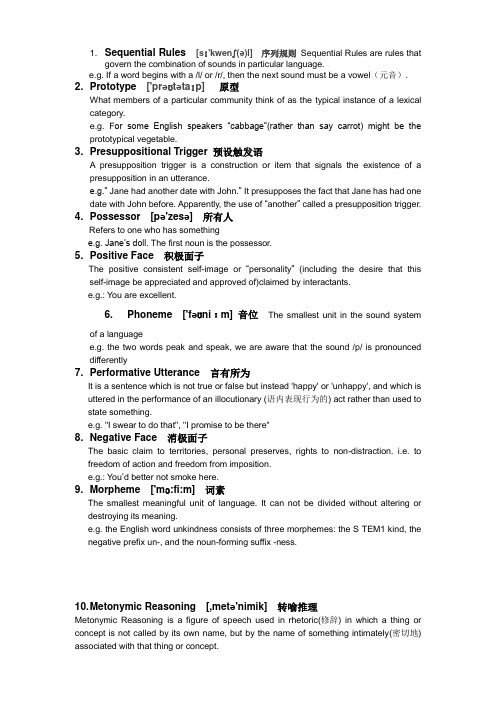
1. Sequential Rules [sɪ'kwenʃ(ə)l] 序列规则Sequential Rules are rules thatgovern the combination of sounds in particular language.e.g. If a word begins with a /l/ or /r/, then the next sound must be a vowel(元音).2. Prototype ['prəʊtətaɪp]原型What members of a particular community think of as the typical instance of a lexical category.e.g. F or some English speakers “cabbage”(rather than say carrot) might be theprototypical vegetable.3. Presuppositional Trigger 预设触发语A presupposition trigger is a construction or item that signals the existence of apresupposition in an utterance.e.g.” Jane had another date with John.” It presupposes the fact that Jane has had onedate with John before. Apparently, the use of “another” called a presupposition trigger.4. Possessor [pə'zesə] 所有人Refers to one who has somethinge.g. Jane’s doll. The first noun is the possessor.5. Positive Face 积极面子The positive consistent self-image or “personality”(including the desire that this self-image be appreciated and approved of)claimed by interactants.e.g.: You are excellent.6. Phoneme ['fəʊniːm] 音位The smallest unit in the sound systemof a languagee.g. the two words peak and speak, we are aware that the sound /p/ is pronounceddifferently7. Performative Utterance 言有所为It is a sentence which is not true or false but instead 'happy' or 'unhappy', and which is uttered in the performance of an illocutionary (语内表现行为的) act rather than used to state something.e.g. "I swear to do that", "I promise to be there"8. Negative Face 消极面子The basic claim to territories, personal preserves, rights to non-distraction. i.e. to freedom of action and freedom from imposition.e.g.: You’d better not smoke here.9. Morpheme ['mɔ:fi:m] 词素The smallest meaningful unit of language. It can not be divided without altering or destroying its meaning.e.g. the English word unkindness consists of three morphemes: the S TEM1 kind, thenegative prefix un-, and the noun-forming suffix -ness.10. Metonymic Reasoning [,metə'nimik] 转喻推理Metonymic Reasoning is a figure of speech used in rhetoric(修辞) in which a thing or concept is not called by its own name, but by the name of something intimately(密切地) associated with that thing or concept.For instance, "London", as the capital of the United Kingdom, can be used as a metonym (an instance of metonymy) for the British governmente.g:silk suits you.”silk stands for the cloth made of silk.11. Truth-conditional Semantics 语义真值条件Truth-conditional Semantics is an approach to semantics(语义学) of natural language that sees the meaning of assertions as being the same as, or reducible to, the truth conditions of that sentence..For example, 'snow is white'.12. Theme [θiːm] 主题Refers to one or thing that undergoes an actione.g.sam found the dog.13. Synonymy [sɪ'nɒnɪmɪ] 近义词/同义词Synonyms are words which have different forms but similar meanings.e.g. Start, begin, commenc e14. Syllable ['sɪləb(ə)l] 音节Syllable is phonological unit which is composed of one or more phonemes.. Every syllable has a nucleus, which is usually a vowel.For example, /let/ consists of one syllable, whereas /ri’ga:d/ consists of two syllables. 15. Source 来源Refers to the place from which an action originates.For example, Sam left Beijing for Nanjing.16. Metaphoric Reasoning 隐喻性思维A word or phrase which is used for special effect, and which does not have its usual or literal meaninge.g. My hands are as cold as ice.17. Location 位置Refers to the place where an action happens,e.g. Jane put the magazines on the table. The table is location.18. Instrument 工具Refers to the means by which an action is performed.For example, the key opened the door.19. Indirect Speech Act 间接言语行为A speech act in which the communicative intention is not reflected in the linguistic form of the utteranceFor example, “It is very hot in here” may be used to e xpress a request to turn on the air conditioner.20. Impersonalization [im,pə:sənəlai'zeiʃən] 非人格化A device used either to avoid mentioning oneself or the interlocutor(对话者), or to appeal to public rule or institutional regulation, which helps to gain successful interpersonal communication.e.g. (1)I don’t think you can smoke in the waiting room, sir. (2)Smoking is not allowed in the waiting room, sir. Obviously, (2) is more polite than (1).21. Hyponymy [haɪ'pɒnɪmɪ] 下义词A relationship between two words, in which the meaning of one word includes the meaning of the other words.e.g. tiger, lion, elephant and dog are hyponyms of the word animal.22. Goal 目标Refers to the place to which an action is directed.For example, Sam left Beijing for Nanjing.23. Functional Shift 词性转换Words may shift from one part of speech to another without the addition of affixes.e.g. noun to verb, to knee, to tape, to break.24. Family Resemblance 家族类似性That a lexical category(词汇范畴) resembles another one can be called family resemblance.e.g. the notion概念of game. One game may resemble类似at least one game, although not all of them have to be alike at the same time.25. Experiencer 感受者One who perceives something. Example: Sam was sad.26. Exophoric Reference [,eksəu'fɔrik] 外指Refers to the relation between an entity in the situational context and a linguistic item in the texte.g. he is the man you want to see, said when the mentioned person comes up to the speaker.27. Entailment 限定关系The relationship between two sentences in which the truth of the second is inferred from the truth of the firste.g. john has a boy”entailing”john has a child”.28. Endophoric Reference 内指照应Refers to a relation between two linguistic items in the same texte.g. John loves Jane, he takes great care of her. This is known to all.29. Deictic Exprseeion ['daiktik] 指代表达(指示语)Deictic Exprseeion are linguistic items used to anchor these specific points in the communication event.e.g. here and there, which refer to a place in relation to the speaker: The letter is here. (near the speaker). The letter is over there. (further away from the speaker)30. Coordinate Sentence 并列句contains two or more clauses(从句) are conjoined by a linking word, such as “and”, “or”, “so”, or “but”.e.g. here a star, and there a star31. Constative Utterance [kən'steitiv] ['ʌtərəns] 表述句It’s the descriptions of facts or states of affairs. For example, The earth is round.”32. Componential Analysis 语义成分分析The process that breaks down the meaning of a word into its minimal distinctive features or properties using feature symbols is called componential analysis.For example, boy may be shown as [+human] [+male] [-adult]33. Complex Sentence 复合句A sentence which contains one or more clauses are embedded(嵌) into a main clause to communicate purpose, reason, time, place, manner, or concession.e.g.this is the place where my father worked 10 years ago.34. Clause 从句A clause in English is one unit of organization that contains a subject-predicate structure..A clause may be finite or non-finite.e.g. I hurried home. / Because I was late, they went without me.35. Causative ['kɔ:zətiv] 成为..的原因/使动词A natural force that causes a changeFor example, The flood killed 25.36. Cataphoric Reference [,kætə'fɔ:rik] 后指照应Donates a relation between the current pronominal item and the later occurring expressione.g. This is what John does for Jane, he sends a bunch of roses to her every day.37. Blending ['blendiŋ]混成法Blending s a word formed by combining parts of other wordse.g. smog (formed from smoke and fog)38. Back-formation 逆构(逆成法)New words may be created from already existing words by subtracting a real or supposed affix.e.g. the word “edit” from the pre-existing word “editor” by deleting the assumed suffix “-or”39. Antonymy [æn'tɔnimi] 反义Antonyms are words which are opposite in meaning.e.g. Dead and alive; male and female40. Anaphoric Reference [,ænə'fɔrik] 前指Involves a relation between a preceding referential expression and the current pronominal iteme.g. John loves Jane, he takes great care of her. This is known to all.41. Analogy [ə'nælədʒi] 类比The process by which words are reformed or created on the model of existing grammatical termsFor example, zipper-gate, football-gate, Watergate42. Allophone ['æləufəun] 音位变体Allophone is the phonetic variants of a phoneme in a particular language.e.g. the phoneme /l/ in English can be realized as dark/l/, clear /l/.43. Agent 人物,主格Refers to the one who performs an actionFor example, Sam opened the door.44. Affixation [,æfik'seiʃən] 词缀A bound morpheme that is joined before, after, or within a root or stemIt mainly includes prefixes, suffixes, infixese.g. prefix un-, suffix –ness;infix –foot45. Adjacency Pair [ə'dʒeisənsi] 相邻语对An initiation, say a question or a request, by the first speaker and the response by the second speaker, like an answer to the question or compliance with the request, form an adjacency pair.For example, “what’s your name?”“My name is Tom.”。
语言学名词解释
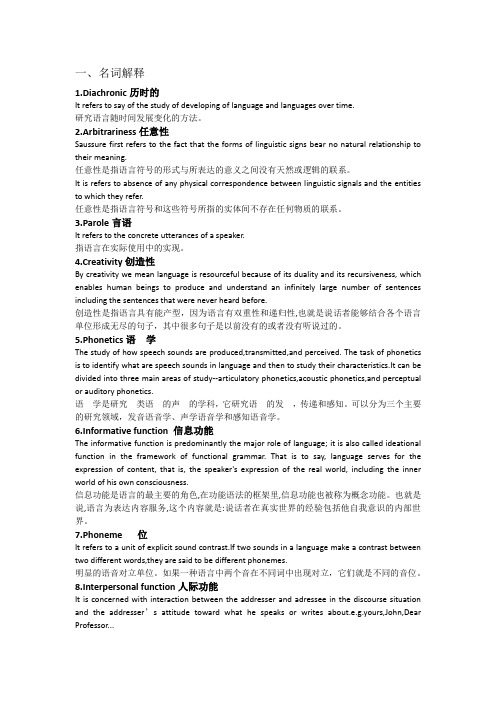
一、名词解释1.Diachronic历时的It refers to say of the study of developing of language and languages over time.研究语言随时间发展变化的方法。
2.Arbitrariness任意性Saussure first refers to the fact that the forms of linguistic signs bear no natural relationship to their meaning.任意性是指语言符号的形式与所表达的意义之间没有天然或逻辑的联系。
It is refers to absence of any physical correspondence between linguistic signals and the entities to which they refer.任意性是指语言符号和这些符号所指的实体间不存在任何物质的联系。
3.Parole言语It refers to the concrete utterances of a speaker.指语言在实际使用中的实现。
4.Creativity创造性By creativity we mean language is resourceful because of its duality and its recursiveness, which enables human beings to produce and understand an infinitely large number of sentences including the sentences that were never heard before.创造性是指语言具有能产型,因为语言有双重性和递归性,也就是说话者能够结合各个语言单位形成无尽的句子,其中很多句子是以前没有的或者没有听说过的。
100个最常用的语言学术语(欧美语言学)
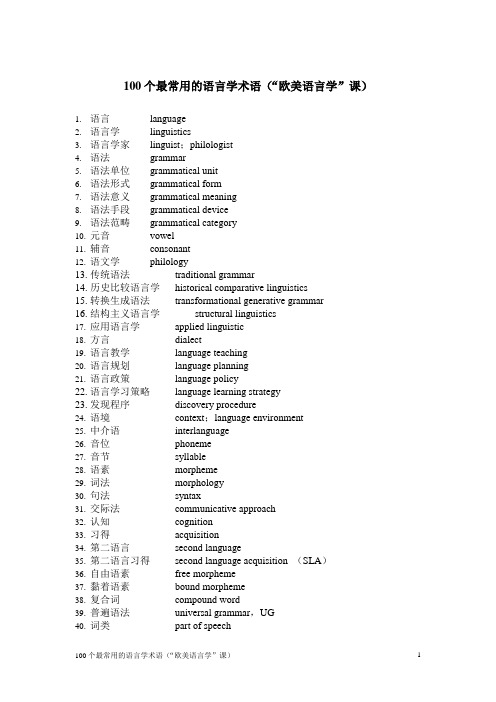
100个最常用的语言学术语(“欧美语言学”课)1.语言language2.语言学linguistics3.语言学家linguist;philologist4.语法grammar5.语法单位grammatical unit6.语法形式grammatical form7.语法意义grammatical meaning8.语法手段grammatical device9.语法范畴grammatical category10.元音vowel11.辅音consonant12.语文学philology13.传统语法traditional grammar14.历史比较语言学historical comparative linguistics15.转换生成语法transformational generative grammar16.结构主义语言学structural linguistics17.应用语言学applied linguistic18.方言dialect19.语言教学language teaching20.语言规划language planning21.语言政策language policy22.语言学习策略language learning strategy23.发现程序discovery procedure24.语境context;language environment25.中介语interlanguage26.音位phoneme27.音节syllable28.语素morpheme29.词法morphology30.句法syntax31.交际法communicative approach32.认知cognition33.习得acquisition34.第二语言second language35.第二语言习得second language acquisition (SLA)36.自由语素free morpheme37.黏着语素bound morpheme38.复合词compound word39.普遍语法universal grammar,UG40.词类part of speech41.直接法direct method42.认同identification43.语言能力language competence44.语言机能language faculty45.交际能力communicative competence46.人工语言artificial language47.外语foreign language48.术语terminology;technical terms49.比较comparison50.对比语言学contrastive linguistics51.词典学lexicography52.母语mother tongue;native language53.语感linguistic intuition54.语料库corpus55.句子sentence56.前缀prefix57.结构structure58.希腊语Greek59.拉丁语Latin60.梵语Sanskrit61.语音学phonetics62.词汇学lexicology;lexics63.语用学pragmatics64.语源学(词源学)etymology65.词典学lexicography66.地理语言学geographic linguistics67.儿童语言学the study of child language68.翻译学translatology69.机器翻译machine translation70.计算语言学computational linguistics71.目的语target language72.普通语言学general linguistics73.社会语言学sociolinguistics74.实验语音学experimental phonetics75.缩略语abbreviation76.统计语言学statistical linguistics77.外来词/外语词loanword;foreign words78.网络语言cyber language;language used on the Internet79.文化语言学cultural linguistics80.心理语言学psycholinguistics81.音译词transliterated word82.语言信息处理language information processing83.语言哲学philosophy of language84.自然语言natural language85.格case86.逻辑学logic;logistics87.修辞学rhetoric88.词word89.相关性relativity90.黏着agglutination91.语言类型学linguistic typology92.音位学phonology;phonemics;phonematics93.构拟reconstruction94.组合关系syntactic relations;syntagma95.聚合关系paradigmatic relations96.功能function97.变体variant98.屈折inflection99.派生derivation100.直接成分immediate constituents (IC)。
语言学专业术语
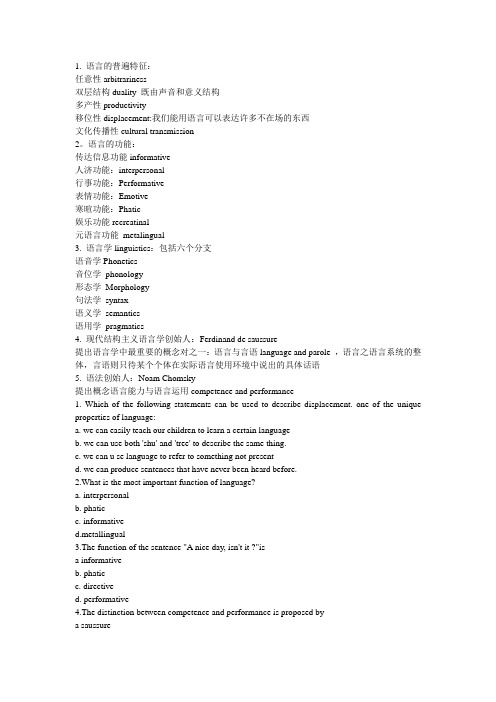
1. 语言的普遍特征:任意性arbitrariness双层结构duality 既由声音和意义结构多产性productivity移位性displacement:我们能用语言可以表达许多不在场的东西文化传播性cultural transmission2。
语言的功能:传达信息功能informative人济功能:interpersonal行事功能:Performative表情功能:Emotive寒暄功能:Phatic娱乐功能recreatinal元语言功能metalingual3. 语言学linguistics:包括六个分支语音学Phonetics音位学phonology形态学Morphology句法学syntax语义学semantics语用学pragmatics4. 现代结构主义语言学创始人:Ferdinand de saussure提出语言学中最重要的概念对之一:语言与言语language and parole ,语言之语言系统的整体,言语则只待某个个体在实际语言使用环境中说出的具体话语5. 语法创始人:Noam Chomsky提出概念语言能力与语言运用competence and performance1. Which of the following statements can be used to describe displacement. one of the unique properties of language:a. we can easily teach our children to learn a certain languageb. we can use both 'shu' and 'tree' to describe the same thing.c. we can u se language to refer to something not presentd. we can produce sentences that have never been heard before.2.What is the most important function of language?a. interpersonalb. phaticc. informatived.metallingual3.The function of the sentence "A nice day, isn't it ?"is __a informativeb. phaticc. directived. performative4.The distinction between competence and performance is proposed by __a saussurec. chomskyd. the prague school5. Who put forward the distinction between language and parole?a. saussureb. chomskyc. hallidayd anomymous第二节语音学1.发音器官由声带the vocal cords和三个回声腔组成2.辅音consonant:there is an obstruction of the air stream at some point of the vocal tract.3.辅音的发音方式爆破音complete obstruction鼻音nasals破裂音plosives部分阻塞辅音partial obstruction擦音fricatives破擦音affricates等4.辅音清浊特征voicing辅音的送气特征aspiration5.元音vowel分类标准舌翘位置,舌高和嘴唇的形状6双元音diphthongs,有元音过渡vowel glides1. Articulatory phonetics mainly studies __.a. the physical properties of the sounds produced in speechb. the perception of soundsc. the combination of soundsd. the production of sounds2. The distinction between vowel s and consonants lies in __a. the place of articulationb.the obstruction f airstreamc. the position of the tongued. the shape of the lips3. What is the common factor of the three sounds: p, k ta. voicelessb. spreadc.voicedd.nasal4. What phonetic feature distinguish the p in please and the p in speak?a. voicingb. aspirationc.roundnessd. nasality5.Which of the following is not a distinctive feature in English?b.nasalc. approximationd. aspiration6.The phonological features of the consonant k are __a. voiced stopb. voiceless stopc. voiced fricatived. voiceless fricative7.p is divverent from k in __a. the manner of articulationb. the shape of the lipsc. the vibration of the vocal cordsd.the palce of articualtion8.Vibration of the vocal cords results in __a. aspirationb.nasalityc. obstructiond. voicing第三节音位学phonology1.音位学与语音学的区别:语音学着重于语音的自然属性,主要关注所有语言中人可能发出的所有声音;音位学则强调语音的社会功能,其对象是某一种语言中可以用来组合成词句的那些语音。
语言学术语整理

语言学常用术语整理1、传统语法:传统语法是指代表前语言学时期语言研究的特征、特别是18和19世纪欧洲学校语法特征的一系列的看法、程序和规定的语法。
后来被结构主义语言学取代,现代中学教学所用的语法都是传统语法。
传统语法的内容:①把语法分为形态学(词法)和造句法(句法)两大部分,以词法为主,详细讲解各类词在句子中的形态变化和语法作用。
句法往往比较简单,主要为词法服务。
②建立了形态学,研究语法形态和语法意义的对应关系。
③建立了句法成分,主语、谓语、为主要成分,宾语、补语是次要成分,定语、状语是附加成分。
传统语法的特点:①它是规范性的语法,由语法学家订立一些条文,规定人们应该怎么说,不应该怎么说,不顾语言事实。
②它重视书面语,比较少或干脆不考虑口语。
③以拉丁语为楷模,它研究语法照搬拉丁语法框架。
④语言分析中重视意义,忽视形式。
⑤忽视语言结构层次。
贡献:虽然传统语法有许多缺点,但它作为语言学史上的第一个语法学派奠定了语法学基础,对普及语法知识起到了巨大的作用;虽然现在语法学派林立,但名词、动词、形容词、语法形式、语法意义、语法手段、主语、宾语等语法范畴在各学派的体系中仍然使用,所以说传统语法对语法学具有开创作用。
2、结构主义语法:结构主义语法是在对传统语法评判的基础上建立起来的,创始人是瑞士语言学家索绪尔,经典著作是《普通语言学教程》,提出了一整套语言学理论。
后来发展成三个分支学派:布拉格学派、哥本哈根学派和美国描写语言学派。
其中以美国描写语言学派的影响最大,代表人物是布龙菲尔德,集大成者是哈里斯。
结构主义语法的基本主张:①语法只能是描写语言,即说明人们怎样说一种语言,而不能像传统语法那样规定人们该怎么说。
②语法必须从形式出发描写语言,而不是像传统语法那样从意义出发来探讨语言。
提出根据分布划分词类。
③强调语言的内部层次,提出用“直接成分分析法”对句法结构进行分析。
④语言单位切分的方法:替代法、分布、转换法、对比分析法。
语言学术语
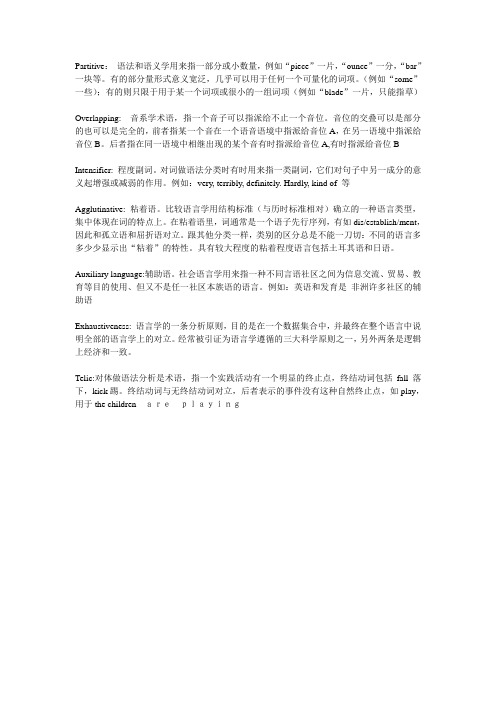
Partitive:语法和语义学用来指一部分或小数量,例如“piece”一片,“ounce”一分,“bar”一块等。
有的部分量形式意义宽泛,几乎可以用于任何一个可量化的词项。
(例如“some”一些);有的则只限于用于某一个词项或很小的一组词项(例如“blade”一片,只能指草)Overlapping: 音系学术语,指一个音子可以指派给不止一个音位。
音位的交叠可以是部分的也可以是完全的,前者指某一个音在一个语音语境中指派给音位A,在另一语境中指派给音位B。
后者指在同一语境中相继出现的某个音有时指派给音位A,有时指派给音位BIntensifier: 程度副词。
对词做语法分类时有时用来指一类副词,它们对句子中另一成分的意义起增强或减弱的作用。
例如:very, terribly, definitely. Hardly, kind of 等Agglutinative: 粘着语。
比较语言学用结构标准(与历时标准相对)确立的一种语言类型,集中体现在词的特点上。
在粘着语里,词通常是一个语子先行序列,有如dis/establish/ment,因此和孤立语和屈折语对立。
跟其他分类一样,类别的区分总是不能一刀切:不同的语言多多少少显示出“粘着”的特性。
具有较大程度的粘着程度语言包括土耳其语和日语。
Auxiliary language:辅助语。
社会语言学用来指一种不同言语社区之间为信息交流、贸易、教育等目的使用、但又不是任一社区本族语的语言。
例如:英语和发育是非洲许多社区的辅助语Exhaustiveness: 语言学的一条分析原则,目的是在一个数据集合中,并最终在整个语言中说明全部的语言学上的对立。
经常被引证为语言学遵循的三大科学原则之一,另外两条是逻辑上经济和一致。
Telic:对体做语法分析是术语,指一个实践活动有一个明显的终止点,终结动词包括fall落下,kick踢。
终结动词与无终结动词对立,后者表示的事件没有这种自然终止点,如play,用于the childrenareplaying。
语言学教程术语

语言学教程术语第一章语言学导论phonology音系学grammar语法学morphology形态学syntax句法学lexicology词汇学general linguistics普通语言学theoretical linguistics理论语言学historical linguistics历史语言学descriptive linguistics描写语言学empirical linguistics经验语言学dialectology方言学anthropology人类学stylistics文体学signifier能指signified所指morphs形素morphotactics 语素结构学/形态配列学syntactic categories句法范畴syntactic classes句法类别序列sub-structure低层结构super-structure上层结构open syllable开音节closed syllable闭音节checked syllable成阻音节rank 等级level层次ding-dong theory/nativistic theory本能论sing-song theory唱歌说yo-he-ho theory劳动喊声说pooh-pooh theory感叹说ta-ta theory模仿说animal cry theory/bow-wow theory模声说Prague school布拉格学派Bilateral opposition 双边对立Mutilateral opposition多边对立Proportional opposition部分对立Isolated opposition 孤立对立Private opposition表缺对立Graded opposition渐次对立Equipollent opposition均等对立Neutralizable opposition可中立对立Constant opposition恒定对立Systemic-functional grammar系统功能语法Meaning potential意义潜势Conversational implicature会话含义Deictics指示词Presupposition预设Speech acts言语行为Discourse analysis话语分析Contetualism语境论Phatic communion寒暄交谈Metalanguage原语言Applied linguistics应用语言学Nominalism唯名学派Psychosomatics身学第二章语音trachea/windpipe气管tip舌尖blade舌叶/舌面front舌前部center舌中部top舌顶back舌后部dorsum舌背root舌跟pharynx喉/咽腔laryngeals喉音laryngealization喉化音vocal cords 声带vocal tract声腔initiator启动部分pulmonic airstream mechanism肺气流机制glottalic airstream mechanism喉气流机制velaric airstream mechanism腭气流机制Adam’s apple喉结Voiceless sound清音Voiceless consonant请辅音Voiced sound浊音Voiced consonant浊辅音Glottal stop喉塞音Breath state呼吸状态Voice state带音状态Whisper state耳语状态Closed state封闭状态Alveolar ride齿龈隆骨Dorsum舌背Ejective呼气音Glottalised stop喉塞音Impossive内爆破音Click/ingressive吸气音Segmental phonology音段音系学Segmental phonemes音段音位Suprasegmental超音段Non-segmental非音段Plurisegmental复音段Synthetic language综合型语言Diacritic mark附加符号Broad transcription宽式标音Narrow transcription窄式标音Orthoepy正音法Orthography正字法Etymology词源Active articulator 积极发音器官Movable speech organ能动发音器官Passive articulator消极发音器官Immovable speech organ不能动发音器官Lateral边音Approximant [j,w]无摩擦延续音Resonant共鸣音Central approximant中央无摩擦延续音Lateral approximant边无摩擦延续音Unilateral consonant单边辅音Bilateral consonant双边辅音Non-lateral非边音Trill [r]颤音trilled consonant颤辅音rolled consonant滚辅音Labal-velar唇化软腭音Interdental齿间音Post-dental后齿音Apico-alveolar舌尖齿龈音Dorso-alveolar舌背齿龈音Palato-alveolar后齿龈音Palato-alveolar腭齿龈音Dorso-palatal舌背腭音Pre-palatal前腭音Post-palatal后腭音Velarization软腭音化Voicing浊音化Devoicing清音化Pure vowel纯元音Diphthong二合元音Triphthong三合元音Diphthongization二合元音化Monophthongization单元音化Centring diphthong央二合元音Closing diphthong闭二合元音Narrow diphthong窄二合元音Wide diphthong宽二合元音Phonetic similarity语音相似性Free variant自由变体Free variation自由变异Contiguous assimilation临近同化Juxtapostional assimilation邻接同化Regressive assimilation逆同化Anticipatory assimilation先行同化Progressive assimilation顺同化Reciprocal assimilation互相同化Coalescent assimilation融合同化Partial assimilation部分同化Epenthesis 插音Primary stress主重音Secondary stress次重音Weak stress弱重音Stress group重音群Sentence stress句子重音Contrastive stress对比重音Lexical stress词汇重音Word stress词重音Lexical tone词汇声调Nuclear tone核心声调Tonetics声调学Intonation contour语调升降曲线Tone units声调单Intonology语调学Multilevel phonology多层次音系学Monosyllabic word 多音节词Polysyllabic word单音节次Maximal onset principle最大节首辅音原则第三章词汇liaison连音contracted form缩写形式frequency count词频统计a unit of vocabulary词汇单位a lexical item词条a lexeme词位hierarchy层次性lexicogrammar词汇语法morpheme语素nonomorphemic words单语素词polymorphemic words多语素词relative uninterruptibility相对连续性a minimum free form最小自由形式the maximum free form最大自由形式variable words可变词invariable words不变词paradigm聚合体grammatical words(function words)语法词/功能词lexical words(content words)词汇词/实义词closed-class words封闭类词opened-class words开放类词word class词类particles小品词pro-form代词形式pro-adjective(so)代形容词pro-verb(do/did)代副词pro-adverb(so)代动词pro-locative(there)代处所词/代方位词determiners限定词predeterminers前置限定词central determiners中置限定词post determiners后置限定词ordinal number序数词cardinal number基数morpheme词素morphology形态学free morpheme自由词素bound morpheme黏着词素root词根affix词缀stem词干root morpheme词根语素prefix前缀infix中缀suffix后缀bound root morpheme 黏着词根词素inflectional affix屈折词缀derivational affix派生词缀inflectional morphemes屈折语素derivational morphemes派生语素word-formation构词compound复合词endocentric compound向心复合词exocentric compound离心复合词nominal endocentric compound名词性向心复合词adjective endocentric compound形容词性向心复合词verbal compound动词性复合词synthetic compound综合性复合词derivation派生词morpheme语素phoneme音位morphonology形态语音学morphophomemics形态音位学morphemic structure语素结构phonological structure音素结构monosyllabic单音节polysyllabic多音节phonological conditioned音位的限制morphological conditioned形态的限制coinage/invention新创词语blending混成法abbreviation缩写法acronym首字母缩写法back-formation逆序造次/逆构词法analogical creation类比构词法borrowing借词法loanword借词loanblend混合借词loanshift 转移借词loan translation翻译借词loss脱落addition添加metathesis换位assimilation同化contact assimilation接触性同化contiguous assimilation临近性同化theory of least effort省力理论non- contiguous assimilation非临近性同化distant assimilation远距离同化morpho-syntactic change形态-句法变化morphological change形态变化syntactical change句法变化finite element有定成分semantic change语义变化multisemous多种意义broadening 词义扩大narrowing词义缩小meaning shift词义转移class shift词性变换folk etymology俗词源orthographic change拼写的变化conversion变换/变码domain范围/领域meaning shift意义转移split infinitives分裂不定式(She was told to regularly classes)calque仿造词语clipping截断法metanalysis再分化finiteness定式proximate(this)近指代词obviative(that)远指代词non-productivity/unproductive非多产性semiotics符号学paradigmatic relations聚合关系associative relations联想关系syntagmatic relations组合关系sequential relations序列关系logogram语标register语域passive vocabulary消极词汇lexis/vocabulary词汇表第四章句法number数gender性case格nominative主格vocative呼格accusative宾格genitive属格dative 与格ablative离格tense 时aspect体perfective完成体imperfective未完成concord/agreement 一致关系/协同关系government支配关系the governor支配者the governed被支配者signified 能指signifier所systematic relationship组合关系paradigmatic relationship聚合关系associative relationship联想关系animate noun有生名词the two axes两根坐标坐标轴immediate constituent analysis(IC analysis for short)直接成分分析法linear structure线性结构hierarchical structure层级结构construction结构体constituent成分substitutability替换性labeled tree diagram标签树形图endocentric/headed construction向心结构/中心结构exocentric construction离心结构subordinate construction主从结构coordinate construction并列结构recapitulation再现the declarative陈述句the interrogative疑问句dative movement与格移位morph-phonemic rule形态音位规则constituent morphemes成分规则affix hopping词缀越位nominalization名物化object-deletion宾语删除subject-deletion主语删除categories语类lexicon词库temporal subject表时间的主语syntactic limitation句法限制standard theory标准理论trace theory语迹理论the same index带同标志government管辖binding约束a rule system规则系统a principle system原则系统constituent command(C-command for short)成分统制plain English普通英语anaphor照应语pronominal指代语r-expression_r(referential-expression_r)指称语INFL(inflection)形态变化reciprocals(each other)相互代词accessible subject可及主语local domain局部语域binding domain约束语域logophoricity主人公视角CS(computational system)计算系统Merger合并move移动theme主位rheme述位empty subject空主语objective order客观顺序subjective order主观顺序actual sentence division实义句子切分法functional sentence perspective功能句子观communicative dynamism (CD)交际动力bipartition二分法tripartite classification三分法representative function表达功能expressive function表情功能appellative/vocative function称呼功能conative function意欲功能poetic function诗学功能ideational function概念功能interpersonal function人际功能textual function语篇功能transitivity及物性actor动作者mood system语气系统the finite verbal operator限定部分residue剩余部分indicative直陈语气imperative祈使语气mental-process(a process of sensing)心理过程(感觉过程)relational process(a process of being)关系过程(属性过程)verbal process(a process of saying)言语过程(讲话过程)existential process生存过程empiricism经验主义(洛克,白板说)rationalism 理性主义(笛卡尔)mentalism心灵主义new empiricism新经验主义(Bloomfield)priori先天综合判断(康德Kant)Cartesian linguistics笛卡尔语言学派Syntactic structure (SS)早期转换句法时期Standard theory (ST)标准理论时期Extended Standard theory (EST)扩展的标准理论Revised Standard theory(REST)扩展的休正标准理论The theory of government and binding (GB theory)管辖和约束理论时期(管约论)Minimalist program (MP)最简方案时期Structural description结构描写式Performance system应用系统Modular theory模块理论Spell-out拼写Language faculty语言机制/官能Mental organ心智器官Knowledge of language 语言知识Meaning potential 意义潜势Context culture 文化语境Field语场Tenor语旨Mode语式pivot words轴心词mental construct心理构念theoretical cognitive psychology理论认知心理学psychological faculty心理官能autosyn/autogram/autoknow语法自主(arbitrariness任意性,systemacity系统性, self-containedness自足性)typological functionalism类型学功能主义extreme functionalism极端的功能主义external functionalism外部功能主义integrative functionalism一体化功能注主义exceptional case marking例外格标记specifier标定成分fall-category maximal projection全语类的最大投射two-segment category两节语类complement domain补足语区域minimal domain最小区域internal domain内部区域checking domain检验区域sisterhood姐妹关系minimizing chain link最小语链联结representational system表达系统strict cyclic principle严格的层级条件structure-preserving principle结构保存原则C-commanding condition成分统领条件articulatory-perceptual system发音-听音系统conceptual-intentional system概念-意旨系统interface conditions中介条件full-interpretation完全解释原则procrastination逻辑形式操作优先原则greed句法操作自利原则the shortest linkage principle最短联接原则the shortest movement principle最短移位原则primary complement/modifier(referential NP)一级补语位/修饰语位(定指名词短语)secondary complement(non- referential NP) 二级补语位(非定指名词短语)empty category principle空范畴原则aspect checking特征验证aspect feature基本体貌特征ASPP is functional projection .ASPP 是功能投射.crossing branch交叉分支across the board extraction抽取跨界移动principles-and-parameters framework原则与参数语法head parameter 中心语参数logical form(LF)逻辑形式phonetic form(PF)语音形式phonological component音韵部分overt component显性部分covert component隐性部分core computation核心运算asymmetric c-command不对称成分统制linear correspondence axiom线形对应定理adjunction 加接determiner限定词concatenate联结linearization线性化functional parameterization hypothesis功能参数设定假设right-branching右向分支X’(V,N,A,P)词项X’’=XP=Xmax是X 的二阶投射结构Y’’=指示语specifier Z’’=补述语complement IP=屈折短语inflection phraseXP=general phrase structureCHL人类语言的运算系统=computational system for human languageLCA线性对应定理=linear correspondence axiom Xmin=X0=最小投射。
语言学术语表
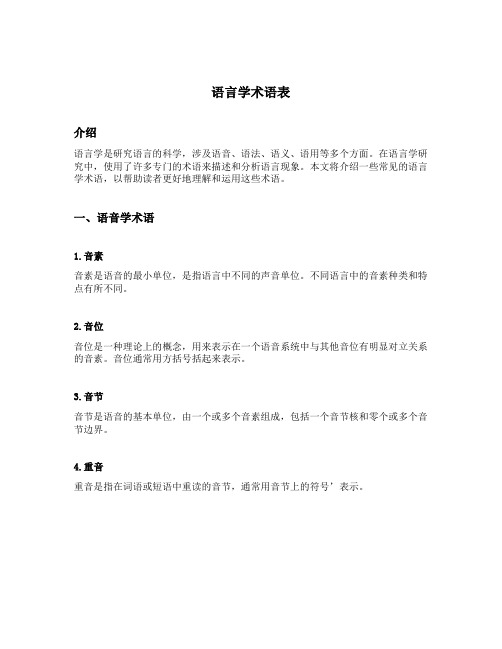
语言学术语表介绍语言学是研究语言的科学,涉及语音、语法、语义、语用等多个方面。
在语言学研究中,使用了许多专门的术语来描述和分析语言现象。
本文将介绍一些常见的语言学术语,以帮助读者更好地理解和运用这些术语。
一、语音学术语1.音素音素是语音的最小单位,是指语言中不同的声音单位。
不同语言中的音素种类和特点有所不同。
2.音位音位是一种理论上的概念,用来表示在一个语音系统中与其他音位有明显对立关系的音素。
音位通常用方括号括起来表示。
3.音节音节是语音的基本单位,由一个或多个音素组成,包括一个音节核和零个或多个音节边界。
4.重音重音是指在词语或短语中重读的音节,通常用音节上的符号’表示。
1.词类词类是用来分类词语的一种方式,常见的词类包括名词、动词、形容词、副词等。
2.句子句子是用来表达完整意义的语言单位,通常包括主语、谓语和宾语等成分。
3.短语短语是由词语组成的一个语言单位,包括名词短语、动词短语、形容词短语等。
4.主谓一致主谓一致是指主语和谓语在人称和数上保持一致,是语法中一个重要的原则。
三、语义学术语1.词义词义是指词语所具有的意义,包括字面义和引申义两种。
2.同义词同义词是指具有相同或相近词义的词语,可以在一定程度上互换使用。
3.反义词反义词是指意义相对、相反的词语,可以用来表达相反的概念。
4.上下位词上下位词是指表示具体事物和一般概念之间的关系的词语,如“苹果”和“水果”的关系。
1.语用语用是指语言在具体交际实践中的使用和理解。
2.语用推断语用推断是指通过上下文和语境等信息来推断语言表达的意义。
3.语用失误语用失误是指由于不当的语言使用导致的交际上的错误或误解。
4.言外之意言外之意是指在言辞之外所蕴含的意义,需要通过语境等信息进行理解。
以上仅是语言学中的一部分学术术语,通过学习和应用这些术语,可以更好地认识和分析语言现象,提高语言能力和语言理解的水平。
希望本文能够帮助读者理解和运用这些语言学术术语,进一步探索语言学的奥秘。
英语语言学概论名词解释汇总

英语语言学概论名词解释汇总英语语言学概论是研究英语语言的基本原理和结构的学科。
在这门学科中,有许多重要的名词需要解释,以便更好地理解英语语言的各个方面。
下面是一些常见的英语语言学术语和其解释:1. 语言:人类使用的一种符号系统,用于交流和表达意思。
2. 语音:语言中的声音单元,用于区分不同的词汇和语法形式。
3. 语法:语言中词汇和句法结构的规则系统,用于构建和理解句子。
4. 词汇:语言中的词汇单位,用于表示特定的意思。
5. 句法:句子的结构和组织方式,包括短语和句子之间的关系。
6. 语义:词汇和句子的意义和解释。
7. 语用学:语言使用的实际情境和交际目的的研究。
8. 语篇分析:研究句子和段落如何组成连贯的文本的过程。
9. 语音学:语音的科学研究,包括语音的产生、传播和感知。
10. 语音变体学:研究语音变化和发音差异的学科。
11. 语音库:包含语音录音和相关信息的数据库。
12. 语音识别:使用计算机技术将语音转换为文字的过程。
13. 语音合成:使用计算机技术将文字转换为语音的过程。
14. 语言变体:同一语言在不同地区或社会群体中的变化形式。
15. 方言:某个特定地区或社会群体使用的语言变体。
16. 标准语:在教育和媒体等公共场合使用的规范语言形式。
17. 语言接触:不同语言之间的互动和影响。
18. 二语习得:学习者将自己的母语转换为第二语言的过程。
19. 语言教学:帮助学习者学习和掌握一门语言的过程。
20. 语言规划:改变或发展一种语言的过程,包括制定规范和推广使用。
这些名词只是英语语言学概论中的一部分,通过学习和理解这些名词,可以更好地理解和分析英语语言的各个方面。
语言学概论名词解释
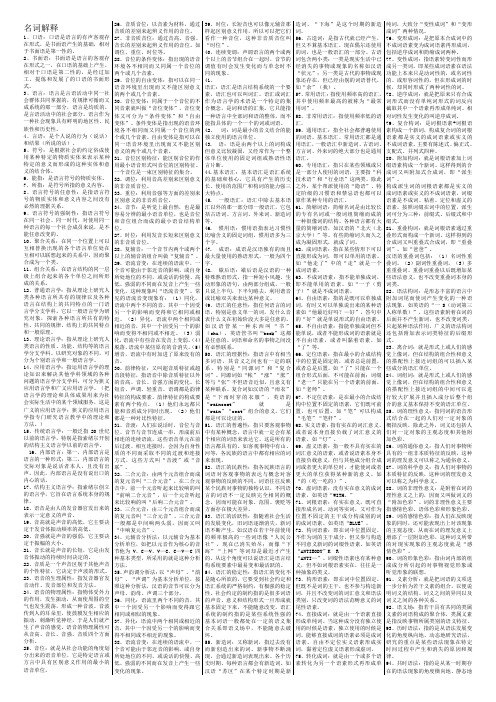
名词解释1、口语:口语是语言的有声客观存在形式,是书面语产生的基础,相对于书面语是第一性的。
2、书面语:书面语是语言的客观存在形式之一,在口语的基础上产生,相对于口语是第二性的,是经过加工、提炼和发展了的口语的书面形式。
3、语言:语言是言语活动中同一社会群体共同掌握的,有规律可循而又成系统的那一部分,语言是均质的,是言语活动中的社会部分。
语言作为一种社会现象具有鲜明的地区性、民族性和历史性。
4、言语:是个人说的行为(说话)和结果(所说的话)。
5、符号:是根据社会的约定俗成使用某种特定的物质实体来表示某种特定的意义而形成的这种实体和意义的结合体。
6、能指:是语言符号的物质实体。
7、所指:是符号所指的意义内容。
8、语言符号的任意性:是指语言符号的物质实体和意义内容之间没有必然的理据关系。
9、语言符号的强制性:指语言符号在同一社会、同一时代,对使用同一种语言的每一个社会成员来说,是不能任意改变的。
10、聚合关系:在同一个位置上可以互相替换出现的各个语言单位处在互相可以联想起来的关系中,因而聚合成为一个类。
11、组合关系:在语言结构的同一层级上组合起来的各个单位之间所形成的关系。
12、普通语言学:指从理论上研究人类各种语言所共有的规律以及各种语言在结构上的共同特点的一门语言学分支学科。
它以一般语言学为研究对象,探索各种语言所共有的特性、共同的规律、结构上的共同特点和一般原理。
13、理论语言学:指从理论上研究人类语言的性质、功能、结构等的语言学分支学科。
以研究对象的不同,可分为个别语言学和一般语言学。
14、应用语言学:指运用语言学的理论知识来解决其他学科领域的各种问题的语言学分支学科,可分为狭义应用语言学和广义应用语言学。
(把语言学的理论和具体成果用来为社会实际生活中的某个领域服务,这是广义的应用语言学;狭义的应用语言学指专门研究语言教学中的理论和方法。
)15、传统语言学:一般泛指20世纪以前的语言学,特别是指索绪尔开创的结构主义语言学以前的语言学。
语言学名词解释汇总
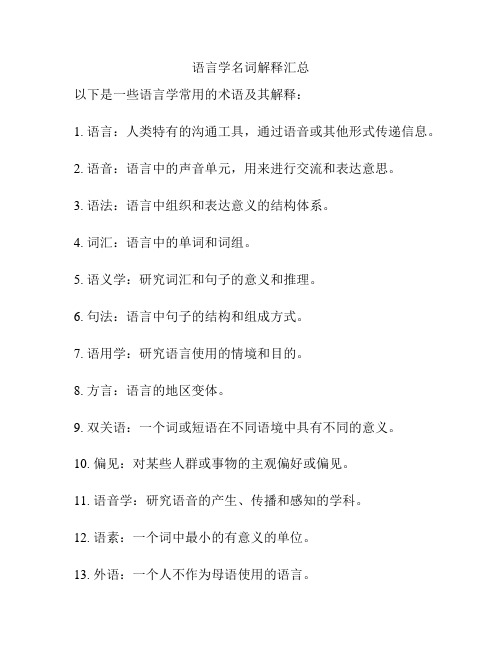
语言学名词解释汇总
以下是一些语言学常用的术语及其解释:
1. 语言:人类特有的沟通工具,通过语音或其他形式传递信息。
2. 语音:语言中的声音单元,用来进行交流和表达意思。
3. 语法:语言中组织和表达意义的结构体系。
4. 词汇:语言中的单词和词组。
5. 语义学:研究词汇和句子的意义和推理。
6. 句法:语言中句子的结构和组成方式。
7. 语用学:研究语言使用的情境和目的。
8. 方言:语言的地区变体。
9. 双关语:一个词或短语在不同语境中具有不同的意义。
10. 偏见:对某些人群或事物的主观偏好或偏见。
11. 语音学:研究语音的产生、传播和感知的学科。
12. 语素:一个词中最小的有意义的单位。
13. 外语:一个人不作为母语使用的语言。
14. 语义角色:句子中表示动作的参与者和受益者的角色。
15. 同音异义词:发音相同但意义不同的词。
16. 语体:语言在不同社会和文化环境下的变体。
17. 口音:由不同语音特征引起的发音差异。
18. 父语:一个人从小学习和使用的第一种语言。
19. 旁观者理论:社会心理学概念,指的是观察者对特定语言
和文化的理解。
20. 叙事学:研究叙述结构和故事生成的学科。
这只是一些常用的语言学术语,语言学是一个非常广泛的学科,还有很多其他的术语可供学习和研究。
术语解释

《语言学》术语解释:1.语系:(1)语系是按照“谱系分类”的方法,根据语言间亲属关系的有无,把世界上的语言所分成的不同的类,凡是有亲属关系的语言都属于同一语系,反之则属于不同的语系。
(2)比如汉语、藏语、壮语、傣语、苗语等是亲属语言。
它们都属于汉藏语系。
(3)世界上的诸语言按其亲属关系大致可以分为汉藏语系、印欧语系、乌拉尔语系、阿尔泰语系、闪含语系、高加索语系、达罗毘语系、马来—玻利尼西亚语系、南亚语系九大语系。
2.歧义:歧义句是在理解上会产生两种可能的句子,换句话说,就是可以这样理解也可以那样理解的句子。
也就是谓语言文字的意义不明确,有两种或几种可能的解释。
一个句子有两种或两种以上的解释,就会产生歧义,歧义产生的原因:词义不明确、句法不固定、层次不分明、指代不明歧义有主要由口语与书面的差别造成的,有主要由多义词造成的,还有语言组合造成的。
组合的歧义中又有语法组合的歧义和语义组合的歧义。
3符号1.符号就是由一定的形式构成的表示一定意义的记号或标记,它包括形式和意义两个方面,指称现实现象。
例如红绿灯就是一种符号,红灯表示“停止“的意义。
符号是人们共同约定用来指称一定对象的标志物,它可以包括以任何形式通过感觉来显示意义的全部现象。
在这些现象中某种可以感觉的东西就是对象及其意义的体现者它有两个方面的内涵:一方面它是意义的载体,是精神外化的呈现;另一方面它具有能被感知的客观形式。
3.字母:拼音文字或注音符号的最小书写单位。
如:英文字母;汉语拼音字母。
4.基础方言:(1)一种语言的共同语并不是凭空产生的,而是在某一个方言的基础上形成的,这种作为共同语基础的方言叫做“基础方言”。
(2)所谓作为共同语的基础指共同语的语音、语汇和语法系统主要来自基础方言。
(3)例如,意大利共同语的基础方言是多斯岗方言,现代汉民族共同语的基础方言是北方方言。
5.共同语:指一个部落或民族内部大多数成员所共同掌握和使用的语言。
它是在某个区域的人们在日常生活中以口语的形式逐渐形成的。
(完整word版)语言学 术语翻译及术语解释
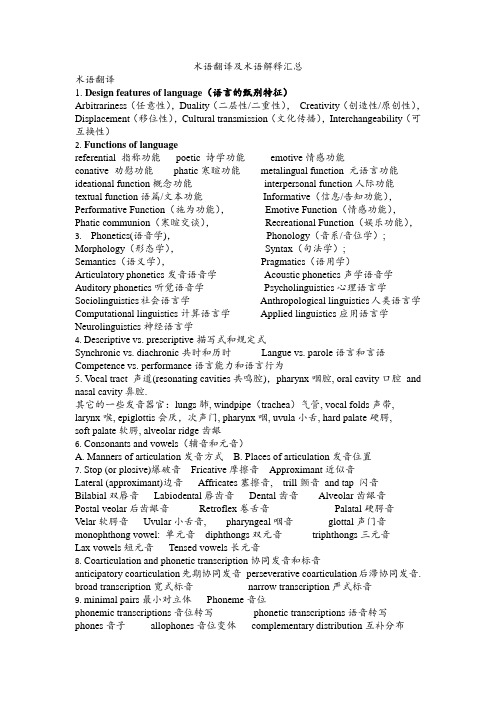
术语翻译及术语解释汇总术语翻译1.Design features of language(语言的甄别特征)Arbitrariness(任意性),Duality(二层性/二重性),Creativity(创造性/原创性),Displacement(移位性),Cultural transmission(文化传播),Interchangeability(可互换性)2. Functions of languagereferential 指称功能poetic 诗学功能emotive情感功能conative 劝慰功能phatic寒暄功能metalingual function 元语言功能ideational function概念功能interpersonal function人际功能textual function语篇/文本功能Informative(信息/告知功能),Performative Function(施为功能),Emotive Function(情感功能),Phatic communion(寒暄交谈),Recreational Function(娱乐功能),3. Phonetics(语音学),Phonology(音系/音位学); Morphology(形态学),Syntax(句法学);Semantics(语义学),Pragmatics(语用学)Articulatory phonetics发音语音学Acoustic phonetics声学语音学Auditory phonetics听觉语音学Psycholinguistics心理语言学Sociolinguistics社会语言学Anthropological linguistics人类语言学Computational linguistics计算语言学Applied linguistics应用语言学Neurolinguistics神经语言学4. Descriptive vs. prescriptive描写式和规定式Synchronic vs. diachronic共时和历时Langue vs. parole语言和言语Competence vs. performance语言能力和语言行为5. V ocal tract 声道(resonating cavities共鸣腔),pharynx咽腔, oral cavity口腔and nasal cavity鼻腔.其它的一些发音器官:lungs肺, windpipe(trachea)气管, vocal folds声带, larynx喉, epiglottis会厌,次声门, pharynx咽, uvula小舌, hard palate硬腭,soft palate软腭, alveolar ridge齿龈6.Consonants and vowels(辅音和元音)A. Manners of articulation发音方式B. Places of articulation发音位置7. Stop (or plosive)爆破音Fricative摩擦音Approximant近似音Lateral (approximant)边音Affricates塞擦音, trill颤音and tap 闪音Bilabial双唇音Labiodental唇齿音Dental齿音Alveolar齿龈音Postal veolar后齿龈音Retroflex卷舌音Palatal硬腭音Velar软腭音Uvular小舌音, pharyngeal咽音glottal声门音monophthong vowel: 单元音diphthongs双元音triphthongs三元音Lax vowels短元音Tensed vowels长元音8.Coarticulation and phonetic transcription协同发音和标音anticipatory coarticulation先期协同发音perseverative coarticulation后滞协同发音. broad transcription宽式标音narrow transcription严式标音9. minimal pairs最小对立体Phoneme音位phonemic transcriptions音位转写phonetic transcriptions语音转写phones音子allophones音位变体complementary distribution互补分布phonetic similarity发音近似性Free variation自由变体assimilation同化regressive assimilation逆同化progressive assimilation顺同化phonological rule 音系规则Epenthesis增音binary 二分的Distinctive features区别特征Endocentric and Exocentric Constructions向心结构和离心结构subordinate and coordinate从属和并列Conceptual meaning概念意义Associative meaning:联想意义Connotative meaning内涵意义Social meaning社会意义Affective meaning情感意义Reflected meaning反射意义Collocative meaning搭配意义Thematic meaning主位意义denotation: 外延意义connotation: 内涵The referential theory:指称理论Semantic triangle语义三角Sense and reference:涵义和指称Synonymy同义关系Antonymy反义关系Hyponymy上下义关系Polysemy一词多义关系Homonymy 同音/形异意关系Dialectal synonyms 地域同义词Stylistic synonyms风格同义词Collocational synonyms搭配同义词gradable antonymy 等级反义关系cover term覆盖项Marked vs. unmarked terms标记项和非标记项complementary antonymy 互补反义关系converse antonymy 逆向反义关系homophones: 同音异义词homographs : 同形异义词complete homonyms semantic components语义部分术语解释1.Design feature的定义:the defining(最典型的,起决定作用的)properties ofhuman language that distinguish it from any animal system of communication. 2.Synchronic共时:It refers to the description of a language at some point of timein history.3.Diachronic历时:It studies the development or history of language. In otherwords, it refers to the description of a language as it changes through time .4.prescriptive规定式:A kind of linguistic s tudy aims to lay down rules for “correctand standard” behavior in using language.5.descriptive描写式: A kind of linguistic study aims to describe and analyze thelanguage people actually use.6.Arbitrariness(任意性):By saying that “language is arbitrary”, we mean thatthere is no logical connection between meaning and sound.7.Duality(二层性/二重性):it means that language is a system, which consists oftwo levels of structures, at the lower level there is the structure of sounds; at the higher level there is the structure of meaning.8.Displacement(移位性): it means that language can be used to communicateabout things that are not present in our immediate communicational context.petence语言能力:it refers to an ideal speaker’s knowledge of the underlyingsystem of rules in a language.10.Performance语言行为: it refers to the actual use of the language by a speaker ina real communicational context.ngue语言: it refers to the speaker’s understanding and knowledge of thelanguage that he speaks.12.Parole言语: it is the actual speaking of language by an individual speaker.13.Cultural transmission(文化传播):It refers to the fact that the details of thelinguistic system must be learned anew(重新,再)by each speaker. Language is not transmitted biologically from generation to generation.14.Phatic communion(寒暄交谈):it refers to ritual exchanges, exchanges that havelittle meaning but help to maintain our relationships with other people.15.Phonetics(语音学): it is the study of the characteristics of speech sounds andprovides methods for their description, classification and transcription.16.V owels元音:the sounds in the production of which no articulators come veryclose together and the air-stream passes through the vocal tract without obstruction.17.Consonants辅音:The sounds in the production of which there is an obstructionof the air-stream at some point of the vocal tract.18.Phonology: it is the study of the sound systems of languages and it is concernedwith the linguistic patterning of sounds in human languages. And it studies the way in which speakers of a language systematically use a selection of these sounds in order to express meaning.19.Phoneme音位: the smallest unit of sound in a language which can distinguish twowords.20.Allophone音位变体: it refers to the different forms of a phoneme.21.Assimilation: it is a process by which one sound takes on some or all thecharacteristics of a neighboring sound.22.Coarticulation: a kind of phonetic process in which simultaneous or overlappingarticulations are involved.plementary distribution互补分布:when two sounds never occur in thesame environment, they are in complementary distribution.24.Free variation自由变体: if two sounds occurring in the same environment do notcontrast, that is, the substitution of one for the other does not produce a different word form, but merely a different pronunciation of the same word, then the two sounds are in free variation.25.Distinctive features区别特征:A phonetic feature which distinguishes onephonological unit, especially one phoneme, from another.26.minimal pairs最小对立体----- which can be defined as pairs of words whichdiffer from each other by only one sound.27.vowel glides滑音: The vowels involving movement from one sound to anotherare called vowel glides.28.Epenthesis增音:it means a process of inserting a sound after another sound.29.Substitution relation: it refers to the relation specifically between an individualunit and others that can replace it in a given sequence.30.Endocentric construction is one whose distribution is functionally equivalent, orapproaching equivalence, to one of its constituents, which serves as the centre, or head, of the whole.31.Exocentric construction: a group of syntactically related words where none ofthem is functionally equivalent to the group as a whole, that is, there is no definable center or head inside the group32.Reference: it is the relationship between words and the objects, actions orproperties that the words stand for. It deals with the extra-linguistic relationships between words and expressions and the world they describe.(具体的物质性的东西)33.Synonymy :It refers to the sameness sense relations between words.ponential analysis :Componential analysis defines the meaning of alexical element in terms of semantic components语义部分.35.Sense: it refers to the complex system of relationships that hold between linguisticelements themselves, it is concerned only with intra-linguistic relations.(概念性的东西)36.Semantics:semantics is the study of the meaning of linguistic units, words andsentences in particular.37.Homonymy: the phenomenon that words having different meanings have the sameform, i.e., different words are identical in sound or spelling, or in both.38.Antonymy:It refers to the oppositeness sense relations between words.39.Hyponymy上下义关系:Hyponymy indicates sense inclusiveness. The upperterm in this sense relation is called superordinate上义词,and the lower terms, hyponyms下义词, members of the same class are called co-hyponyms.。
语言学概论名词解释
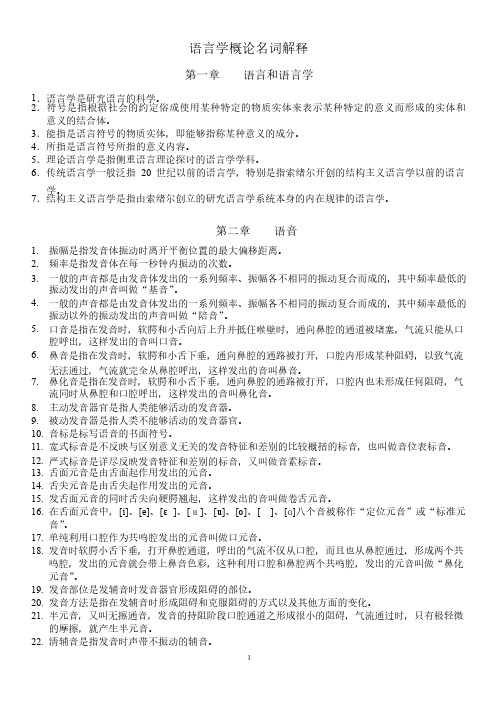
语言学概论名词解释语言学概论名词解释第一章第一章 语言和语言学语言和语言学1.语言学是研究语言的科学。
.语言学是研究语言的科学。
2.符号是指根据社会的约定俗成使用某种特定的物质实体来表示某种特定的意义而形成的实体和意义的结合体。
意义的结合体。
3.能指是语言符号的物质实体,即能够指称某种意义的成分。
4.所指是语言符号所指的意义内容。
.所指是语言符号所指的意义内容。
5.理论语言学是指侧重语言理论探讨的语言学学科。
6.传统语言学一般泛指20世纪以前的语言学,特别是指索绪尔开创的结构主义语言学以前的语言学。
学。
7.结构主义语言学是指由索绪尔创立的研究语言学系统本身的内在规律的语言学。
第二章第二章 语音语音1. 振幅是指发音体振动时离开平衡位置的最大偏移距离。
2. 频率是指发音体在每一秒钟内振动的次数。
3. 一般的声音都是由发音体发出的一系列频率、一般的声音都是由发音体发出的一系列频率、振幅各不相同的振动复合而成的,振幅各不相同的振动复合而成的,振幅各不相同的振动复合而成的,其中频率最低的其中频率最低的振动发出的声音叫做“基音”。
4. 一般的声音都是由发音体发出的一系列频率、一般的声音都是由发音体发出的一系列频率、振幅各不相同的振动复合而成的,振幅各不相同的振动复合而成的,振幅各不相同的振动复合而成的,其中频率最低的其中频率最低的振动以外的振动发出的声音叫做“陪音”。
5. 口音是指在发音时,软腭和小舌向后上升并抵住喉壁时,通向鼻腔的通道被堵塞,气流只能从口腔呼出,这样发出的音叫口音。
腔呼出,这样发出的音叫口音。
6. 鼻音是指在发音时,软腭和小舌下垂,通向鼻腔的通路被打开,口腔内形成某种阻碍,以致气流无法通过,气流就完全从鼻腔呼出,这样发出的音叫鼻音。
7. 鼻化音是指在发音时,软腭和小舌下垂,通向鼻腔的通路被打开,口腔内也未形成任何阻碍,气流同时从鼻腔和口腔呼出,这样发出的音叫鼻化音。
8. 主动发音器官是指人类能够活动的发音器。
英语语言学专业术语

英语语言学专业术语英语语言学是研究英语语言的起源、发展、结构和使用的学科。
以下是常见的英语语言学专业术语及其解释。
1. Phonetics(音系学):研究语音的学科。
主要研究语音发音过程,包括语音的组成、发音方式和特点等。
2. Phonology(音韵学):研究语音在语言中的功能和规律的学科。
主要研究语音在不同语境下的变化规律和相互关系,包括音素、音位和音系等。
3. Morphology(形态学):研究语言中单词的形态和构成的学科。
主要研究单词的基本单位和构成规律,包括词根、词缀和词类等。
4. Syntax(句法学):研究句子结构和句子组成的学科。
主要研究句子的构成和排列方式,包括短语、从句和主谓结构等。
5. Semantics(语义学):研究语言意义的学科。
主要研究语言符号和意义之间的关系,包括单词、短语和句子的意义等。
6. Pragmatics(语用学):研究语言使用的学科。
主要研究语言与社会文化环境的关系,包括语境、语用规则和交际意图等。
7. Discourse analysis(话语分析):研究语篇结构和语篇功能的学科。
主要研究语言在话语交际中的组织和作用,包括话语行为、话语结构和话语分析方法等。
8. Sociolinguistics(社会语言学):研究语言和社会文化因素之间的关系和影响的学科。
主要研究不同社会群体、文化背景和地理区域中语言使用的差异和变化,包括方言、语言变体和语言政策等。
9. Psycholinguistics(心理语言学):研究语言和心理过程之间的关系的学科。
主要研究语言理解、语言产生和语言习得等心理过程,包括语音知觉、语法处理和语言记忆等。
以上是英语语言学常见的专业术语及其解释,希望能够帮助你更好地了解英语语言学。
语言学专业术语

1. 语言的普遍特征:任意性arbitrariness双层结构duality 既由声音和意义结构多产性productivity移位性displacement:我们能用语言可以表达许多不在场的东西文化传播性cultural transmission2。
语言的功能:传达信息功能informative人济功能:interpersonal行事功能:Performative表情功能:Emotive寒暄功能:Phatic娱乐功能recreatinal元语言功能metalingual3. 语言学linguistics:包括六个分支语音学Phonetics音位学phonology形态学Morphology句法学syntax语义学semantics语用学pragmatics4. 现代结构主义语言学创始人:Ferdinand de saussure提出语言学中最重要的概念对之一:语言与言语language and parole ,语言之语言系统的整体,言语则只待某个个体在实际语言使用环境中说出的具体话语5. 语法创始人:Noam Chomsky提出概念语言能力与语言运用competence and performance1. Which of the following statements can be used to describe displacement. one of the unique properties of language:a. we can easily teach our children to learn a certain languageb. we can use both 'shu' and 'tree' to describe the same thing.c. we can u se language to refer to something not presentd. we can produce sentences that have never been heard before.2.What is the most important function of language?a. interpersonalb. phaticc. informatived.metallingual3.The function of the sentence "A nice day, isn't it ?"is __a informativeb. phaticc. directived. performative4.The distinction between competence and performance is proposed by __a saussurec. chomskyd. the prague school5. Who put forward the distinction between language and parole?a. saussureb. chomskyc. hallidayd anomymous第二节语音学1.发音器官由声带the vocal cords和三个回声腔组成2.辅音consonant:there is an obstruction of the air stream at some point of the vocal tract.3.辅音的发音方式爆破音complete obstruction鼻音nasals破裂音plosives部分阻塞辅音partial obstruction擦音fricatives破擦音affricates等4.辅音清浊特征voicing辅音的送气特征aspiration5.元音vowel分类标准舌翘位置,舌高和嘴唇的形状6双元音diphthongs,有元音过渡vowel glides1. Articulatory phonetics mainly studies __.a. the physical properties of the sounds produced in speechb. the perception of soundsc. the combination of soundsd. the production of sounds2. The distinction between vowel s and consonants lies in __a. the place of articulationb.the obstruction f airstreamc. the position of the tongued. the shape of the lips3. What is the common factor of the three sounds: p, k ta. voicelessb. spreadc.voicedd.nasal4. What phonetic feature distinguish the p in please and the p in speak?a. voicingb. aspirationc.roundnessd. nasality5.Which of the following is not a distinctive feature in English?b.nasalc. approximationd. aspiration6.The phonological features of the consonant k are __a. voiced stopb. voiceless stopc. voiced fricatived. voiceless fricative7.p is divverent from k in __a. the manner of articulationb. the shape of the lipsc. the vibration of the vocal cordsd.the palce of articualtion8.Vibration of the vocal cords results in __a. aspirationb.nasalityc. obstructiond. voicing第三节音位学phonology1.音位学与语音学的区别:语音学着重于语音的自然属性,主要关注所有语言中人可能发出的所有声音;音位学则强调语音的社会功能,其对象是某一种语言中可以用来组合成词句的那些语音。
prescriptive和descriptive例子
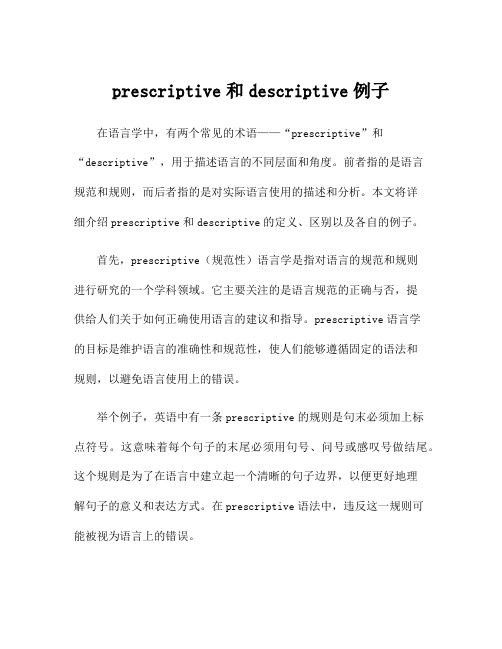
prescriptive和descriptive例子在语言学中,有两个常见的术语——“prescriptive”和“descriptive”,用于描述语言的不同层面和角度。
前者指的是语言规范和规则,而后者指的是对实际语言使用的描述和分析。
本文将详细介绍prescriptive和descriptive的定义、区别以及各自的例子。
首先,prescriptive(规范性)语言学是指对语言的规范和规则进行研究的一个学科领域。
它主要关注的是语言规范的正确与否,提供给人们关于如何正确使用语言的建议和指导。
prescriptive语言学的目标是维护语言的准确性和规范性,使人们能够遵循固定的语法和规则,以避免语言使用上的错误。
举个例子,英语中有一条prescriptive的规则是句末必须加上标点符号。
这意味着每个句子的末尾必须用句号、问号或感叹号做结尾。
这个规则是为了在语言中建立起一个清晰的句子边界,以便更好地理解句子的意义和表达方式。
在prescriptive语法中,违反这一规则可能被视为语言上的错误。
与之相对的,descriptive(描述性)语言学是对实际语言使用进行描述和分析的研究。
它关注的是人们在日常语言中的实际表达方式,而不是某种规范或约束。
descriptive语言学的目标是记录语言的实际使用情况,研究人们如何在实际交流中运用各种语言结构和规则。
再以英语为例,descriptive语言学会研究实际生活中人们的语言表达方式,包括口语、书面语以及各种变体和方言。
例如,人们在北美口语中常常使用“ain't”这个词来代替“is not”或“are not”。
从prescriptive角度看,使用“ain't”是非标准的,因为它不符合传统的语法规则。
但从descriptive角度看,人们在实际使用中仍然频繁使用它,因此该词的存在可以被认为是一种实际存在的语言现象。
区别prescriptive和descriptive的一个重要方面是它们对语言规则和语法的态度不同。
常见语言学术语大全
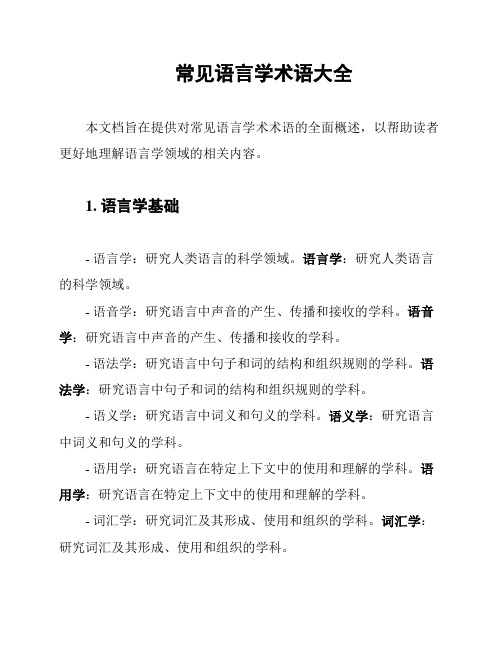
常见语言学术语大全本文档旨在提供对常见语言学术术语的全面概述,以帮助读者更好地理解语言学领域的相关内容。
1. 语言学基础- 语言学:研究人类语言的科学领域。
语言学:研究人类语言的科学领域。
- 语音学:研究语言中声音的产生、传播和接收的学科。
语音学:研究语言中声音的产生、传播和接收的学科。
- 语法学:研究语言中句子和词的结构和组织规则的学科。
语法学:研究语言中句子和词的结构和组织规则的学科。
- 语义学:研究语言中词义和句义的学科。
语义学:研究语言中词义和句义的学科。
- 语用学:研究语言在特定上下文中的使用和理解的学科。
语用学:研究语言在特定上下文中的使用和理解的学科。
- 词汇学:研究词汇及其形成、使用和组织的学科。
词汇学:研究词汇及其形成、使用和组织的学科。
- 文字学:研究文字和书写系统的学科。
文字学:研究文字和书写系统的学科。
2. 语音学术语- 音素:语言中的最小语音单位。
音素:语言中的最小语音单位。
- 音位:在特定语言中有区别意义的音素。
音位:在特定语言中有区别意义的音素。
- 音节:由一个或多个音素组成的发音单位。
音节:由一个或多个音素组成的发音单位。
- 语调:声音的音高和音量的变化模式,用于传达陈述、疑问、感叹等语气。
语调:声音的音高和音量的变化模式,用于传达陈述、疑问、感叹等语气。
- 重音:在一个词中或一个句子中某个音节的发音强调。
重音:在一个词中或一个句子中某个音节的发音强调。
3. 语法学术语- 句子:由一个或多个词组成的完整语言表达。
句子:由一个或多个词组成的完整语言表达。
- 主语:动作的执行者或者状态的拥有者。
主语:动作的执行者或者状态的拥有者。
- 谓语:陈述主语的动作或状态。
谓语:陈述主语的动作或状态。
- 宾语:动作的承受者或者状态的受事者。
宾语:动作的承受者或者状态的受事者。
- 定语:修饰名词或代词的词或词组。
定语:修饰名词或代词的词或词组。
- 状语:修饰动词、形容词或者副词的词或词组。
- 1、下载文档前请自行甄别文档内容的完整性,平台不提供额外的编辑、内容补充、找答案等附加服务。
- 2、"仅部分预览"的文档,不可在线预览部分如存在完整性等问题,可反馈申请退款(可完整预览的文档不适用该条件!)。
- 3、如文档侵犯您的权益,请联系客服反馈,我们会尽快为您处理(人工客服工作时间:9:00-18:30)。
acronym: is made up from the first letters of the name of an organization, which has a heavily modified headword. affix: the collective term for the type of formative that can be used only when added to another morpheme (the root or stem). Allophone: any of the different forms of a phoneme(e g. [t h] is an allophone of /t/ in English. When /t/ occurs in words like step, it is unaspirated [t]. Both [t h] and t] are allophones of the phoneme /t/. applied linguistics: applications of linguistics to the study of second and foreign language learning and teaching, and other areas such as translation, the compiling of dictionaries, etc. arbitrariness: one design feature of human language, which refers to the face that the forms of linguistic signs bear no natural relationship to their meaning. articulatoryphonetics: the studyof production ofspeech sounds.assimilation: thechange of a sound asa result of theinfluence of anadjacent sound,which is morespecifically called“contact”or“contiguous”assimilation.assimilation theory:language (sound,word, syntax, etc)change or processby which features ofone element changeto match those ofanother thatprecedes or follows.back-formation: anabnormal type ofword-formationwhere a shorterword is derived bydeleting animagined affix froma longer formalready in thelanguage.blending: arelatively complexform ofcompounding, inwhich two words areblended by joiningthe initial part of thefirst word and thefinal part of thesecond word, or byjoining the initialpars of the twowords.bound morpheme:an element ofmeaning which isstructurallydependent on theworld it is added to,e. g. the pluralmorpheme in dogˊs.broad and narrowtranscription: theuse of a simple setof symbols intranscription iscalled broadtranscription; theuse of a simple setof symbols intranscription iscalled broadtranscription; while,the use of morespecific symbols toshow more phoneticdetail is referred toas narrowtranscription.category: parts ofspeech and function,such as theclassification ofwords in terms ofparts of speech, theidentification ofterms of parts ofspeech, theidentification offunctions of wordsin term of subject,predicate, etc.creativity:bycreativity we meanlanguage isresourceful becauseof its duality and itsrecursiveness. Oneof the reasons whylanguage is actuallya far morecomplicated entitythan traffic lights isthat we can use it tocreate newmeanings.concord: alsoknown as agreement,is the requirementthat the forms oftwo or more wordsin a syntaeticrelationship shouldagree with eachother in terms ofsome categories.coarticulation: akind of phoneticprocess in whichsimultaneous oroverlappingarticulations areinvolved.Coarticulation canbe further dividedinto anticipatorycoarticulation andperseverativecoarticulation.compound:Polymorphemicwords which consistwholly of freemorphemes, such asclassroom,blackboard,snowwhite, etc.complementarydistribution: the relation between two speech sounds that never occur in the same environment. Allophones of the same phoneme are usually in complementary distribution. competence: language user’s underlying knowledge about the system of rules. consonant: they are sound segments produced by constricting or obstructing the vocal tract at some place to divert, impede, or completely shut off the flow of air in the oral cavity. complementary antonymy: members of a pair in complementary antonymy are complementary to each field completely, such male: female, present: absent. compositionality: a principle for sentence analysis, in which the meaning of a sentence depends on the meanings of the constituent wordsand the way they arecombined.conceptualmeaning: thecentral par ofmeaning, whichcontains logical,cognitive, ordenotative content.connotation: a termin a contrast withdenotation, meaningthe properties of theentity a worddenotes.converse antonymy:a special kind ofantonymy in thatremembers of a pairdo not constitute apositive-negativeopposition; such asbuy; sell, lend:borrow, above:below, etc.communicativecompetence: asdefined by Hymes,the knowledge andability involved inputting language tocommunicative use.Conversationalimplicature: theextra meaning notcontained in theliteral utterances,understandable tothe listener onlywhen he shares thespeaker’sknowledge or knowswhy and how heviolatesintentionally one ofthe four maxims ofthe CooperativePrinciple(CP).constative: anutterance by which aspeaker expresses apropisition whichmay be true or false.CP (CooperativePrinciple): tospecify the CPfurther, Griceintroduced fourcategories ofmaxims as follows:Quantity: make yourcontribution asinformation as isrequired. Quality:try to make yourcontribution one thatis true. Relation: berelevant. Manner: beperspicuous.deep structure: theabstractrepresentation of thesyntactic propertiesof a construction, i.e. the underlyinglevel of structuralrelations between itsdifferentconstituents, such asthe relation between.The underlyingsubject and its verb,or a verb and itsobject.descriptive: a kindof linguistic study inwhich things are justdescribed.denotation: the coresense of a word or aphrase that relates itto phenomena in thereal world.diachronic: thestudy of a languageis carried throughthe course of itshistory.dialect: A regionalvariety of alanguagedistinguished bypronunciation,grammar, orvocabulary,especially a varietyof speech differingfrom the standardliterary language orspeech pattern of theculture in which itexists:displacement: onedesign feature ofhuman language,which means humanlanguage enabletheir users tosymbolize objects,events and conceptswhich are notpresent c in time andspace, at themoment ofcommunication.Distinctive features:a term of phonology,i. e. a propertywhich istinguishesone phoneme fromanother.dissimilatoin: the influence exercised. By one sound segment upon the articulation of another, so that the sounds become less alike, or different. duality: one design feature of human language, which refers to the property of having two levels of are composed of elements of the secondary level and each of the two levels has its own principles of organization. endocentric construction: one construction whose distribution is functionally equivalent, or approaching equivalence, to one of its constituents, which serves as the centre, or head, of the whole. Hence an endocentric construction is also known as a headed construction. exocentric construction: a construction whose distribution is not functionally equivalent t Any to any of its constituents.emic: a term incontrast with eticwhich originatesfrom Americanlinguist Pike’sdistinction ofphonetics andphonemics. An ernicset of speech actsand events must beone that is validatedas meaningful viafinal reaurce to thenative members of aspeech communityrather than viaappeal to theinvestigator’singenuity orintuition alone.etic: a term incontrast with emicwhich originatesfrom Americanlinguist Pike’sdistinction ofphonetics andphonemics. Beingetic mans makingfar too many, as wellas behaviouslyinconsequential,differentiations, justas was often thecase with phoneticvs. phonemicanalysis inlinguistics proper.etymology:Theorigin and historicaldevelopment of alinguistic form asshown bydetermining its basicelements, earliestknown use, andchanges in form andmeaning, tracing itstransmission fromone language toanother, identifyingits cognates in otherlanguages, andreconstructing itsancestral formwhere possible.Fossilization: itrefers to thisphenomenon-non-target forms becomefixed in theinterlanguage. Manyexamples can befound - Mukkatesh,looking at thewritten productionof 80 students at aJordanian university,found that after 11years instruction inlearning English,they continuedmaking errors suchas the use of simplepast instead ofsimple present - noamount ofgrammaticalexplanation or oferror correction hadany effect.folk etymology: achange in form of aword or phrase, resuiting from anincorrect popularnation of the originor meaning of theterm or from theinfluence of morefamiliar termsmistakenly taken tobe analogous.free morpheme: anelement of meaningwhich takes theform of anindependent word.government andbinding theory: it isthe fourth period ofdevelopment ofChomsky’s TGGrammar, whichconsists of x-bartheory, Case Theory,Controll Theory, andBinding Theory.grammatical word:word expressinggrammaticalmeanings, such asconjunctions,prepositions, artidesand pronouns.gradableantongyrny:members of thiskind are gradable, ias long: short, big:small.hyponymy: arelation betweentwo words, in whichthe meaning of oneword (thesuperordinate) isincluded in themeaning anotherword (thehyponym) .ideational function: the speaker’s experience of the real world, including the inner world of his own consciousness. illocutionary act: the act performed in saying something; its force is identical with the speaker’s intention. interlanguage: the type of language constructed by second or foreign language learners who are still in the process of learning a language, i. e. the language system between the target language and the learner’s native language. interpersonal function: the use of language to establish and maintain social relations: for the expression of social roles, which include the communication roles created by language itself; and also for getting things done, by means of the interaction between one person and another inflection: the manifestation ofgrammaticalrelationshipsthrough the additionof inflectionalaffixes, such asnumber, per son,finiteness, aspectand case, which donot change thegrammatical class ofthe stems to whichthey are attached.isolating language:a language in whichword forms do notchange, and inwhich grammaticalfunctions are shownby word order andthe use of functionwords.inflectionallanguage: alanguage in whichthe form of a wordchanges to show achange in meaningor grammaticalfunction, often thereis no cleardistinction betweenthe basic part of theword and the partwhich shows agrammaticalfunction such asnumber or tense.immediateconstituent analysis:the analysis of asentence in terms ofits immediateconstituents—wordgroups (or phrases),which are in turnanalyzed into theimmediateconstituents of theirown, and theprocess goes onuntil the ultimateconstituents arereached.IPA: theabbreviation ofInternationalPhonetic Alphabet,which is devised bythe InternationalPhoneticAssociation in 1888on the basis of thephonetic alphabetproposed at the time.Since then it hasundergone a numberof revisions. IPA is acomprised systememploying symbolsof all sources, suchas Roman smallletters, italicsuprighted, obsoleteletters, Greek letters,diacritics, etc.langue: thelinguisticcompetence of thespeaker.lexeme: A separateunit of meaning,usually in the formof a word(e.g. dogin the manger).lexicon: a list of allthe words in alanguage assigned tovarious lexicalcategories andprovided withsemanticinterpretation.lexical word: wordhaving lexicalmeanings, that is,those which refer tosubstance, actionand quality, such asnouns, verbs,adjectives, andverbs.loanblend: aprocess in whichpart of the form isnative and part isborrowed, but themeaning is fullyborrowed.loanshift: a processin which themeaning isborrowed, but theform is native.loanword: a processin which both formand meaning areborrowed with oniya slight adaptation,in some cases, to thephonological systemof the new languagethat they enter.loss: thedisappearance of thevery sound as amorpheme in thephonologicalsystem.locutionary act: theact of sayingsomething; it’s anact of conveying literal meaning by means of syntax, lexicon ,and phonology. Namely, the utterance of a sentence with determinate sense and reference. macrolinguistics: the interacting study between language and language-related disciplines such as psychology, sociology, ethnograph, science of law and artificial intelligence etc. Branches of rnacrolinguistics include psycholinguistics, sociolinguistics, anthropological linguistics, etc. Manner of articulation: in the production of consonants, manner of articulation refers to the actual relationship between the articulators and thus the way in which the air passes through certain parts of the vocal tract. Meaning: it has always been a central topic in human scholarship, though term “semantics”has only a history of alittle over a hundredyears. The fact thatover the yearsnumerousdictionaries havebeen produced witha view to explainingthe meaning ofwords also bearswitness to its longtradition.Nevertheless,semantics remainsthe least known areain linguistics,compared withphonetics,phonology,morphology andsyntax.metalanguage:certain kinds oflinguistic signs orterms for theanalysis anddescription ofparticular studies.minimal pairs:when two differentforms are identicalin every way expectfor one soundsegment whichoccurs in the placein the string, the twowords are calledminimal pairs.morpheme: thesmallest unit oflanguage in terms ofrelationship betweenexpression andcontent, a unit thatcannot be dividedinto further smallunits withoutdestroying ordrastically alteringthc meaning,whether it is lexicalor grammatical.Q-principle: one ofthe two principles inHorn’s scale, i.e.Make yourcontributionsufficient (ofquantity1) ; Say asmuch as you can(given R).paradigmaticrelation: a relationholding betweenelements replaceablewith each other at aparticular place in astructure, orbetween oneelement present andhe others absent.parole: the actualphenomena or dataof linguistics(utterances).performance: theactual use oflanguage in concretesituations.phatic communion:one function ofhuman language,which refers to thesocial interaction oflanguage.Phoneme: theabstract element ofsound, identified asbeing distinctive in aparticular language.Place ofarticulation: in theproduetion ofconsonants, place ofarticulation refers towhere in the vocaltract there isapproximation ,narrowing, or theobstruction of air.prescriptive: a kindof linguistic study inwhich things areprescribed howought to be, i. e.laying down rulesfor language use.prepositional logic:also known asprepositionalcalculus orsentential calculus,is the study of thetruth Conditions forpropositions: howthe truth of acompositeproposition isdetermined by thetrath value of itsconstituentpropositions and theconnections betweenthem.Propositions:whatever is seen asexpressed by asentence whichmakes a statement.It is a property ofpropositions thatthey have truth values. performative: an utterance by which a speaker does something does something, as apposed to a constative, by which makes a statement which may be true or false.r-principle: one of the two principles in Horn’s scale, i. e. make your contribtution necessary (G. Relation, Quantity2, Manner) ; Say no more than you must (given Q). reference: the use of language to express a proposition, i. e. to talk about things in context.relational opposites: converse antonymy in reciprocal social roles, kinship relations, temporal and spatial relations. There are always tvo entities involved. One presupposes the other. The sho, better: worse, etc are instances of relational opposites. rivation: different from compounds, derivation shows the relation betweenroots and affixes.rlocutionary act:the act performed byor resulting fromsaying soething, it’sthe consequence of,or the changebrought about theutterance.root: the base fromof a word thatcannot further beanalyzed 4.vitl,puttotal loss of identity.allomorph: any ofthe different form ofa morpheme. Forexample, in Englishthe plural morphemeis but it ispronounceddifferently indifferentenvironments as /s/in cats, as /z/ in dogsand as /iz/ in classes.So /s/, /z/, and /iz!are all allomorphs ofthe pluralmorpheme.surface structure:the final stage in thesyntactic derivationof a construction,which closelycorresponds to thestructuralorganization of aconstruction peopleactually produce andreceive.c-command: one ofthe similarities, or ofthe more gener.Stem: anymorpheme orcombination ofrnorphemes towhich an)nfleetionalaffix can be added.syllabus: theplanning of a courseof instruction. It is adescription of thecousr content,teaching proceduresand learningexperiences.synchronic: a kindof description whichtakes a fixed instant(usuai1notnecessarily, thepresent) ,as its pointof observation. Mostgrammars are of thiskind.syntagrnaticrelation: a relationbetween one itemand others in asequence, orbetween elementswhich are allpresent.sense: the literalmeaning of a wordor an expression,independent ofsituational context.synonymy: is thetechnical name forthe samenessrelation.Suprasegmental:Suprasegmentalfeatures are thoseaspects of speechthat involve morethan single soundsegments. Theprincipalsupra-segmentalfeatures are syllable,stress, tone, andintonation.superordinate: theupper term inhyponymy, i. e. theclass name. Asuperordinateusually has severalhyponyrns. Underanimal, for example,there are cats, dogs,pigs, etc.selection restriction:semantic restrictionsof the noun phrasesthat iciilare,cicalitem can take, e. g.regret requires ahuman subject.transfer: theinfluence of mothertongue upon thesecond language.When structures ofthe two languagesare similar, we canget positive transferor facilitation; whenthe two languagesare different instructures, negativetransfer or inferenceoccurs and result inerrors.textual function:the use of languagethe provide formaking links with itself and with features of the situation in which it is used.validity: the degree to which a test meansures what it is meant to measure. There are four kinds of validity, i. e. content validity, construct validity, empirical valiodity, and face validity. voicing: pronouncing a sound (usually a vowel or a voiced consonant by vibrating the vocal cords.Vowel: are sound segments produced without such obstruction so no turbulence of a total stopping of the air can be perceived.。
